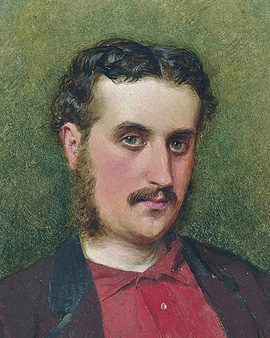George Elgar Hicks was the second son of a wealthy judge. His family lived in the small town of Lymington in the county of Hampshire. His parents wanted the boy to study medicine, so he began to study, but soon found that he had little interest in becoming a doctor. Instead, he was drawn to art and was mainly interested in painting. Therefore he changed at the age of 19 to the art school in Blomsbury and one year later to the Royal Academy of Arts in London. However, his works were at first only moderate and Hicks himself described them as "small and unimportant". At the age of twenty-three George Hicks married his childhood sweetheart Maria Harris. The couple had eight children in quick succession, and that was probably one of the reasons why the artist did not have too much time for art studies, travel, or interaction with other painters. It was not until 10 years later that George Hicks made his breakthrough. His genre painting "Horch, the lark sings at the Gate of Heaven" received some public attention, as did the painting "Divident Day at the Bank of England" and a self-portrait of the painter, which he created in 1862.
George Elgar Hicks painted many large-format pictures showing scenes from the normal everyday life of the English, such as "Fish Market in Billingsgate", "The Post Office", "The Change of Apartment", "Return from Gleaning", "The Farm Girl", "The Fisherman's Wife and the Hunter's Daughter" and "Bad Luck Day". George Elgar Hicks was quite successful. But he did not belong to the great painters of England and his critics considered his paintings to be very deeply felt, interesting in subject matter and brilliant in colour, but often somewhat fleeting in execution and not always completely flawless. He emulated his great model William Powell Frith, a well-known genre painter of his time, but without quite reaching him.
In his later years, when genre painting no longer interested people so much, Hicks concentrated on historical paintings and portraits. After the death of his wife Marie in 1891, he married a second time and retired. George Elgar Hicks was 90 years old.
×





 - (MeisterDrucke-9702).jpg)
 - (MeisterDrucke-9702).jpg)
.jpg)
.jpg)
.jpg)
.jpg)
.jpg)
.jpg)
.jpg)
.jpg)
.jpg)
.jpg)
.jpg)
.jpg)
.jpg)
.jpg)
.jpg)
.jpg)
.jpg)
.jpg)
_-_(MeisterDrucke-1172388).jpg)
_-_(MeisterDrucke-1172388).jpg)
.jpg)
.jpg)
.jpg)
.jpg)
.jpg)
.jpg)
.jpg)
.jpg)
.jpg)
.jpg)
.jpg)
.jpg)
.jpg)
.jpg)
.jpg)
.jpg)
.jpg)
.jpg)
.jpg)
.jpg)
.jpg)
.jpg)
.jpg)
.jpg)
.jpg)
.jpg)
.jpg)
.jpg)
.jpg)
.jpg)
.jpg)
.jpg)
.jpg)
.jpg)
.jpg)
.jpg)
.jpg)
.jpg)
.jpg)
.jpg)
_-_(MeisterDrucke-876506).jpg)
_-_(MeisterDrucke-876506).jpg)
.jpg)
.jpg)
_-_(MeisterDrucke-79095).jpg)
_-_(MeisterDrucke-79095).jpg)
.jpg)
.jpg)
.jpg)
.jpg)
.jpg)
.jpg)
.jpg)
.jpg)
.jpg)
.jpg)
.jpg)
.jpg)
_-_(MeisterDrucke-109409).jpg)
_-_(MeisterDrucke-109409).jpg)
.jpg)
.jpg)
.jpg)
.jpg)
.jpg)
.jpg)
.jpg)
.jpg)
.jpg)
.jpg)
.jpg)
.jpg)
_-_(MeisterDrucke-1106285).jpg)
_-_(MeisterDrucke-1106285).jpg)
.jpg)
.jpg)
.jpg)
.jpg)
_-_(MeisterDrucke-59045).jpg)
_-_(MeisterDrucke-59045).jpg)
.jpg)
.jpg)
_-_(MeisterDrucke-998241).jpg)
_-_(MeisterDrucke-998241).jpg)
.jpg)
.jpg)
_-_(MeisterDrucke-203323).jpg)
_-_(MeisterDrucke-203323).jpg)
.jpg)
.jpg)
.jpg)
.jpg)
.jpg)
.jpg)
.jpg)
.jpg)
.jpg)
.jpg)




